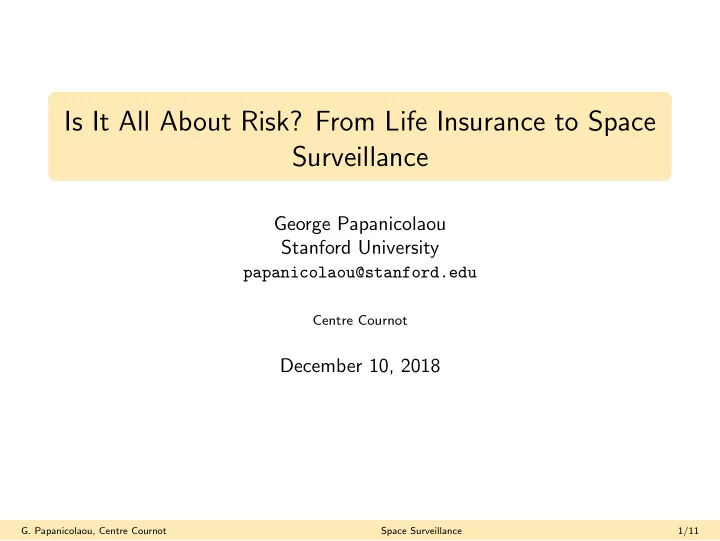

Is It All About Risk? From Life Insurance to Space Surveillance George Papanicolaou Stanford University papanicolaou@stanford.edu Centre Cournot December 10, 2018 G. Papanicolaou, Centre Cournot Space Surveillance 1/11
Sixty one years into the space age • On October 4, 1957, the first man-made satellite went into orbit: A spherical object of diameter 58 cm at an average altitude of about 500 km, and cycling the Earth with a period of 96 minutes. • In Low Earth Orbit (LEO), 200-1500 km, there are some 10,000 objects that are being tracked today. • At higher altitudes, the geosynchronous orbit, which is about 5 Earth radii from the earth’s surface (about 35,000 km), there are some 20,000 objects large enough to be tracked (more than 50 cm in diameter). • At an altitude of 500 km, a satellite travels at a speed of 7.6 km per second (more than 27,000 km per hour) so as to stay in orbit. G. Papanicolaou, Centre Cournot Space Surveillance 2/11
Man-made space debris • More than 170 million pieces of debris of size 1 centimeter and smaller. • They descend in altitude slowly because of drag, on the scale of decades, especially the ones at higher altitudes where there is less drag. • These small objects are fragments from disintegrating larger satellites. They can come from collisions, from booster rockets, etc. • They fly at speeds three to four times faster than bullets from high-performance guns. • When collisions occur in space, they generate a lot of debris that disperses widely. G. Papanicolaou, Centre Cournot Space Surveillance 3/11
Space debris science forty years ago Notable early research on space debris G. Papanicolaou, Centre Cournot Space Surveillance 4/11
Debris distribution today Estimated radial debris distribution G. Papanicolaou, Centre Cournot Space Surveillance 5/11
Notable “collisions” in space • China, in 2007, carried out an anti-missile test in space (800 km) that generated the largest amount of debris in history. It was immediately criticized internationally, and China was probably surprised to learn that debris is indeed an issue of serious concern. • In 2008, the US destroyed a defective satellite that was believed to carry toxic material. It was at an altitude of 250 km. By 2009, most of the debris that was generated had dissipated into the atmosphere below. • Around 2009, the US government became very concerned about the lack of adequate space surveillance capabilities, especially for emergencies. G. Papanicolaou, Centre Cournot Space Surveillance 6/11
Government and private enterprise in space • Until about 2014, most of the activity in space was carried out by the government, mostly the military and NASA. The exceptions were the geosynchronous satellites (about 600), for communications and weather forecasting. • Privately owned and operated satellite constellations (some 1000 small satellites) have begun to appear in the last 5 years in order to provide large-scale and repeated remote sensing services. • Applications: Agriculture, livestock, real estate, forestry, coastline erosion, shifting climate patterns, urban planning, ... • On-demand remote sensing services: A new industry G. Papanicolaou, Centre Cournot Space Surveillance 7/11
But there is RISK • How do you insure an investment of many millions for a satellite constellation in space? • How do you check that the constellation is in normal condition? • Who provides LEO surveillance services on demand? Only one company at this time. • There are huge obstacles in providing reliable and accurate on-demand LEO surveillance. Most difficult one: High-power ground-based radar illumination. Very expensive, now entirely controlled by the government, not flexible, ... G. Papanicolaou, Centre Cournot Space Surveillance 8/11
Need inexpensive and efficient space surveillance Once government funding is gone, then cost and efficiency matter and must be calculated carefully. It is all about tools for risk assessment. And perhaps most important are space surveillance tools that provide diverse information. G. Papanicolaou, Centre Cournot Space Surveillance 9/11
What we propose V T Y T e 3 � H T R 2 X E R 1 R 3 X R 3 a e 2 � a e 3 � Legend: Receivers Emitter Scatterer Schematic of drone-based receivers, asynchronous and distributed ground-based radar illumination, and the use of correlation-based imaging (Garnier-Papanicolaou, CUP 2016, and FGPT, SIIMS 2017). G. Papanicolaou, Centre Cournot Space Surveillance 10/11
What are the objectives of our two year (2018-20) project? • Study the limits of low-power ground-based illumination • Study the effects of the atmosphere in satellite imaging, especially at higher frequencies (W-band, 3 mm wavelength) • Study the possibility of imaging simultaneously and in detail large clusters of debris G. Papanicolaou, Centre Cournot Space Surveillance 11/11
Recommend
More recommend